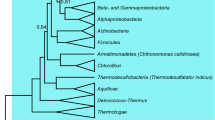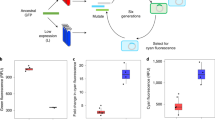Abstract
Most protein mutations, and mutations that alter protein functions in particular, undermine stability and are therefore deleterious. Chaperones, or heat-shock proteins, are often implicated in buffering mutations, and could thus facilitate the acquisition of neutral genetic diversity and the rate of adaptation. We examined the ability of the Escherichia coli GroEL/GroES chaperonins to buffer destabilizing and adaptive mutations. Here we show that mutational drifts performed in vitro with four different enzymes indicated that GroEL/GroES overexpression doubled the number of accumulating mutations, and promoted the folding of enzyme variants carrying mutations in the protein core and/or mutations with higher destabilizing effects (destabilization energies of >3.5 kcal mol -1, on average, versus ∼1 kcal mol -1 in the absence of GroEL/GroES). The divergence of modified enzymatic specificity occurred much faster under GroEL/GroES overexpression, in terms of the number of adapted variants (≥2-fold) and their improved specificity and activity (≥10-fold). These results indicate that protein stability is a major constraint in protein evolution, and buffering mechanisms such as chaperonins are key in alleviating this constraint.
This is a preview of subscription content, access via your institution
Access options
Subscribe to this journal
Receive 51 print issues and online access
$199.00 per year
only $3.90 per issue
Buy this article
- Purchase on Springer Link
- Instant access to full article PDF
Prices may be subject to local taxes which are calculated during checkout




Similar content being viewed by others
References
DePristo, M. A., Weinreich, D. M. & Hartl, D. L. Missense meanderings in sequence space: a biophysical view of protein evolution. Nature Rev. Genet. 6, 678–687 (2005)
Wilke, C. O., Bloom, J. D., Drummond, D. A. & Raval, A. Predicting the tolerance of proteins to random amino acid substitution. Biophys. J. 89, 3714–3720 (2005)
Zeldovich, K. B., Chen, P. & Shakhnovich, E. I. Protein stability imposes limits on organism complexity and speed of molecular evolution. Proc. Natl Acad. Sci. USA 104, 16152–16157 (2007)
Wang, X., Minasov, G. & Shoichet, B. K. Evolution of an antibiotic resistance enzyme constrained by stability and activity trade-offs. J. Mol. Biol. 320, 85–95 (2002)
Tokuriki, N., Stricher, F., Serrano, L. & Tawfik, D. S. How protein stability and new functions trade off. PLOS Comput. Biol. 4, e1000002 (2008)
Wagner, A. Robustness and Evolvability in Living Systems. (Princeton Univ. Press, 2005)
Martin, J. & Hartl, F. U. Chaperone-assisted protein folding. Curr. Opin. Struct. Biol. 7, 41–52 (1997)
Thirumalai, D. & Lorimer, G. H. Chaperonin-mediated protein folding. Annu. Rev. Biophys. Biomol. Struct. 30, 245–269 (2001)
Fares, M. A., Moya, A. & Barrio, E. GroEL and the maintenance of bacterial endosymbiosis. Trends Genet. 20, 413–416 (2004)
Rutherford, S. L. Between genotype and phenotype: protein chaperones and evolvability. Nature Rev. Genet. 4, 263–274 (2003)
Rutherford, S. L. & Lindquist, S. Hsp90 as a capacitor for morphological evolution. Nature 396, 336–342 (1998)
Queitsch, C., Sangster, T. A. & Lindquist, S. Hsp90 as a capacitor of phenotypic variation. Nature 417, 618–624 (2002)
Sangster, T. A., Lindquist, S. & Queitsch, C. Under cover: causes, effects and implications of Hsp90-mediated genetic capacitance. Bioessays 26, 348–362 (2004)
Van Dyk, T. K., Gatenby, A. A. & LaRossa, R. A. Demonstration by genetic suppression of interaction of GroE products with many proteins. Nature 342, 451–453 (1989)
Fares, M. A., Ruiz-González, M. X., Moya, A., Elena, S. F. & Barrio, E. Endosymbiotic bacteria: GroEL buffers against deleterious mutations. Nature 417, 398 (2002)
Maisnier-Patin, S. et al. Genomic buffering mitigates the effects of deleterious mutations in bacteria. Nature Genet. 37, 1376–1379 (2005)
Cowen, L. E. & Lindquist, S. Hsp90 potentiates the rapid evolution of new traits: drug resistance in diverse fungi. Science 309, 2185–2189 (2005)
Sangster, T. A. & Queitsch, C. The HSP90 chaperone complex, an emerging force in plant development and phenotypic plasticity. Curr. Opin. Plant Biol. 8, 86–92 (2005)
Bobula, J. et al. Why molecular chaperones buffer mutational damage: a case study with a yeast Hsp40/70 system. Genetics 174, 937–944 (2006)
Kerner, M. J. et al. Proteome-wide analysis of chaperonin-dependent protein folding in Escherichia coli . Cell 122, 209–220 (2005)
Persson, M., Carlsson, U. & Bergenhem, N. C. GroEL reversibly binds to, and causes rapid inactivation of, human carbonic anhydrase II at high temperatures. Biochim. Biophys. Acta 1298, 191–198 (1996)
Chapman, E. et al. Global aggregation of newly translated proteins in an Escherichia coli strain deficient of the chaperonin GroEL. Proc. Natl Acad. Sci. USA 103, 15800–15805 (2006)
Bershtein, S., Golding, K. & Tawfik, D. Intense drifts yield robust and evolvable consensus proteins. J. Mol. Biol. 379, 1029–1044 (2008)
Tokuriki, N., Stricher, F., Schymkowitz, J., Serrano, L. & Tawfik, D. S. The stability effects of protein mutations appear to be universally distributed. J. Mol. Biol. 369, 1318–1332 (2007)
Sasidharan, R. & Chothia, C. The selection of acceptable protein mutations. Proc. Natl Acad. Sci. USA 104, 10080–10085 (2007)
Amitai, G., Gupta, R. A. & Tawfik, D. S. Latent evolutionary potentials under the neutral mutational drift of an enzyme. HFSP Journal 1, 67–78 (2007)
McLoughlin, S. Y. & Copley, S. D. A compromise required by gene sharing enables survival: implications for evolution of new enzyme activities. Proc. Natl Acad. Sci. USA 105, 13497–13502 (2008)
Roodveldt, C. & Tawfik, D. S. Shared promiscuous activities and evolutionary features in various members of the amidohydrolase superfamily. Biochemistry 44, 12728–12736 (2005)
Le Rouzic, A. & Carlborg, O. Evolutionary potential of hidden genetic variation. Trends Ecol. Evol. 23, 33–37 (2007)
Fontana, W. & Schuster, P. Continuity in evolution: on the nature of transitions. Science 280, 1451–1455 (1998)
Bershtein, S., Segal, M., Bekerman, R., Tokuriki, N. & Tawfik, D. S. Robustness-epistasis link shapes the fitness landscape of a randomly drifting protein. Nature 444, 929–932 (2006)
Yue, P., Li, Z. & Moult, J. Loss of protein structure stability as a major causative factor in monogenic disease. J. Mol. Biol. 353, 459–473 (2005)
Lindner, A. B., Madden, R., Demarez, A., Stewart, E. J. & Taddei, F. Asymmetric segregation of protein aggregates is associated with cellular aging and rejuvenation. Proc. Natl Acad. Sci. USA 105, 3076–3081 (2008)
Noivirt-Brik, O., Unger, R. & Horovitz, A. Low folding propensity and high translation efficiency distinguish in vivo substrates of GroEL from other Escherichia coli proteins. Bioinformatics 23, 3276–3279 (2007)
Radman, M., Matic, I. & Taddei, F. Evolution of evolvability. Ann. NY Acad. Sci. 870, 146–155 (1999)
Taddei, F. et al. Role of mutator alleles in adaptive evolution. Nature 387, 700–702 (1997)
Kerner, M. J. et al. Proteome-wide analysis of chaperonin-dependent protein folding in Escherichia coli . Cell 122, 209–220 (2005)
Roodveldt, C. & Tawfik, D. S. Shared promiscuous activities and evolutionary features in various members of the amidohydrolase superfamily. Biochemistry 44, 12728–12736 (2005)
Roodveldt, C. & Tawfik, D. S. Directed evolution of phosphotriesterase from Pseudomonas diminuta for heterologous expression in Escherichia coli results in stabilization of the metal-free state. Protein Eng. Des. Sel. 18, 51–58 (2005)
Aharoni, A. et al. Directed evolution of mammalian paraoxonases PON1 and PON3 for bacterial expression and catalytic specialization. Proc. Natl Acad. Sci. USA 101, 482–487 (2004)
Kitagawa, M. et al. Complete set of ORF clones of Escherichia coli ASKA library (a complete set of E. coli K-12 ORF archive): unique resources for biological research. DNA Res. 12, 291–299 (2005)
Gould, S. M. & Tawfik, D. S. Directed evolution of the promiscuous esterase activity of carbonic anhydrase II. Biochemistry 44, 5444–5452 (2005)
Nishihara, K., Kanemori, M., Kitagawa, M., Yanagi, H. & Yura, T. Chaperone coexpression plasmids: differential and synergistic roles of DnaK–DnaJ–GrpE and GroEL–GroES in assisting folding of an allergen of Japanese cedar pollen, Cryj2, in Escherichia coli . Appl. Environ. Microbiol. 64, 1694–1699 (1998)
Misset, O. & Opperdoes, F. R. Simultaneous purification of hexokinase, class-I fructose-bisphosphate aldolase, triosephosphate isomerase and phosphoglycerate kinase from Trypanosoma brucei . Eur. J. Biochem. 144, 475–483 (1984)
Yifrach, O. & Horovitz, A. Transient kinetic analysis of adenosine 5′-triphosphate binding-induced conformational changes in the allosteric chaperonin GroEL. Biochemistry 37, 7083–7088 (1998)
Guerois, R., Nielsen, J. E. & Serrano, L. Predicting changes in the stability of proteins and protein complexes: a study of more than 1000 mutations. J. Mol. Biol. 320, 369–387 (2002)
Schymkowitz, J. et al. The FoldX web server: an online force field. Nucleic Acids Res. 33, W382–W388 (2005)
Tokuriki, N., Stricher, F., Schymkowitz, J., Serrano, L. & Tawfik, D. S. The stability effects of protein mutations appear to be universally distributed. J. Mol. Biol. 369, 1318–1332 (2007)
Acknowledgements
Financial support by the EU via the MiFEM consortium, NIH grant number W81XWH-07-2-0020, and Israel Science Foundation are gratefully acknowledged. We are thankful to P. Goloubinoff for his advice, V. Kolotonouv for technical assistance, L. Serrano for the use of FoldX, and A. Horovitz and S. Rutherford for their help in refining this manuscript.
Author Contributions N.T. and D.S.T. designed the study, analysed the data and wrote the manuscript. N.T. performed the experiments.
Author information
Authors and Affiliations
Corresponding author
Supplementary information
Supplementary Information
This file contains Supplementary Tables 1-8 and Supplementary Figures 1-5 with Legends. (PDF 22949 kb)
Rights and permissions
About this article
Cite this article
Tokuriki, N., Tawfik, D. Chaperonin overexpression promotes genetic variation and enzyme evolution. Nature 459, 668–673 (2009). https://doi.org/10.1038/nature08009
Received:
Accepted:
Issue Date:
DOI: https://doi.org/10.1038/nature08009
This article is cited by
-
The difference of intestinal microbiota composition between Lantang and Landrace newborn piglets
BMC Veterinary Research (2023)
-
Balance between promiscuity and specificity in phage λ host range
The ISME Journal (2021)
-
Distinct metabolic states of a cell guide alternate fates of mutational buffering through altered proteostasis
Nature Communications (2020)
-
Accessing unexplored regions of sequence space in directed enzyme evolution via insertion/deletion mutagenesis
Nature Communications (2020)
-
Chaperone client proteins evolve slower than non-client proteins
Functional & Integrative Genomics (2020)
Comments
By submitting a comment you agree to abide by our Terms and Community Guidelines. If you find something abusive or that does not comply with our terms or guidelines please flag it as inappropriate.



